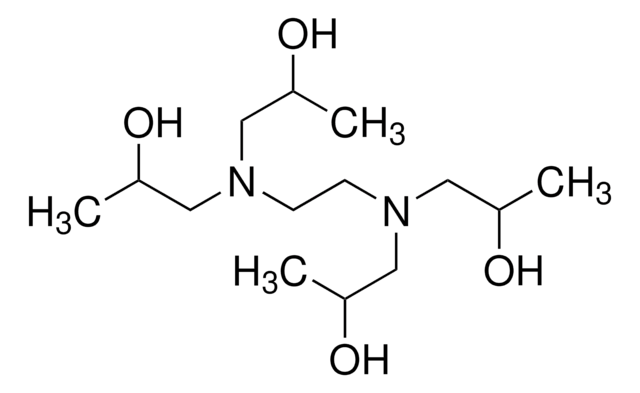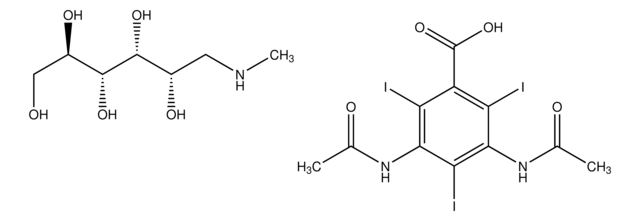Wszystkie zdjęcia(1)
Key Documents
87600
N,N,N′,N′-Tetrakis(2-hydroxyethyl)ethylenediamine
technical
Synonim(y):
2,2′,2″,2″′-(Ethylenedinitrilo)tetraethanol, THEED
Zaloguj sięWyświetlanie cen organizacyjnych i kontraktowych
About This Item
Wzór liniowy:
(HOCH2CH2)2NCH2CH2N(CH2CH2OH)2
Numer CAS:
Masa cząsteczkowa:
236.31
Beilstein:
1767829
Numer WE:
Numer MDL:
Kod UNSPSC:
12352116
Identyfikator substancji w PubChem:
NACRES:
NA.22
Polecane produkty
klasa czystości
technical
Poziom jakości
Postać
liquid
współczynnik refrakcji
n20/D 1.501
tw
~280 °C
gęstość
1.1 g/mL at 20 °C (lit.)
grupa funkcyjna
amine
hydroxyl
ciąg SMILES
OCCN(CCO)CCN(CCO)CCO
InChI
1S/C10H24N2O4/c13-7-3-11(4-8-14)1-2-12(5-9-15)6-10-16/h13-16H,1-10H2
Klucz InChI
BYACHAOCSIPLCM-UHFFFAOYSA-N
Szukasz podobnych produktów? Odwiedź Przewodnik dotyczący porównywania produktów
Opis ogólny
N,N,N′,N′-Tetrakis(2-hydroxyethyl)ethylenediamine, is primarily used as a chelating agent and as a building block in the synthesis of various chemical compounds. It is also useful in metal extraction and catalysis because of its ability to form stable complexes with metal ions.
Zastosowanie
N,N,N′,N′-Tetrakis(2-hydroxyethyl)ethylenediamine can be used as a chelating agent to prepare a palladium-based complex, which is used as a catalyst for the Suzuki/Miyaura reaction.
This page may contain text that has been machine translated.
Kod klasy składowania
10 - Combustible liquids
Klasa zagrożenia wodnego (WGK)
WGK 3
Temperatura zapłonu (°F)
210.2 °F - closed cup
Temperatura zapłonu (°C)
99 °C - closed cup
Środki ochrony indywidualnej
Eyeshields, Gloves
Wybierz jedną z najnowszych wersji:
Masz już ten produkt?
Dokumenty związane z niedawno zakupionymi produktami zostały zamieszczone w Bibliotece dokumentów.
Klienci oglądali również te produkty
Marta I S Veríssimo et al.
ACS sensors, 4(11), 2915-2921 (2019-10-28)
The identification of paper composition, pH, early signs of paper degradation, and emitting volatile organic compounds (VOCs) are mandatory for effective preventive conservation of paper/books. Sampling restrictions in the analysis of cultural heritage materials limit the choice of appropriate analytical
Marko Pende et al.
Science advances, 6(22), eaba0365-eaba0365 (2020-06-12)
Tissue clearing combined with deep imaging has emerged as a powerful alternative to classical histological techniques. Whereas current techniques have been optimized for imaging selected nonpigmented organs such as the mammalian brain, natural pigmentation remains challenging for most other biological
Nasz zespół naukowców ma doświadczenie we wszystkich obszarach badań, w tym w naukach przyrodniczych, materiałoznawstwie, syntezie chemicznej, chromatografii, analityce i wielu innych dziedzinach.
Skontaktuj się z zespołem ds. pomocy technicznej







![1-[N,N-Bis(2-hydroxyethyl)amino]-2-propanol 94%](/deepweb/assets/sigmaaldrich/product/structures/219/539/52108f19-e9a0-4987-b605-9969a5cc720d/640/52108f19-e9a0-4987-b605-9969a5cc720d.png)
![3-[(2-Aminoethyl)amino]-1-propanol AldrichCPR](/deepweb/assets/sigmaaldrich/product/structures/193/734/c3b3e55a-2f61-43c5-8804-ff55209c4b55/640/c3b3e55a-2f61-43c5-8804-ff55209c4b55.png)


